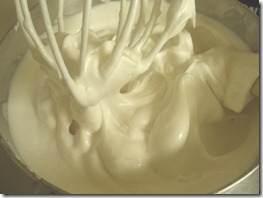
In the continuing saga—or slog—of spring cleaning of the freezer, this week I used up all the egg whites. I had about 2 cups. I thawed them all, then used about a half-cup over the course of a few days for various uses (including a facial mask), and the rest for an angel food cake. Angel food cake is the
perfect use for leftover egg whites. It meets the two crucial criteria previously discussed for freezer inventory: it’s quick, and it uses lots. In fact, an angel cake uses anywhere from 12-14 egg whites, or 1 ½-1 2/3 cups of egg white, depending on egg size. And it has the added benefit of being, of course, delicious. Because it requires so many whites, most people don’t make this old-fashioned cake anymore, and I only make it about once a year (freezer cleaning time). So it is sort of special.
Before getting into the cake itself, it might be worth talking about the storing of egg whites in the first place. Obviously, every time you make something that calls for an egg yolk, either for extra richness or to glaze something, you should put the unused white away in the freezer. I like to use a glass canning jar because you can more easily track how many you have as you go; I usually also mark the number on a piece of tape on the lid, sort of like keeping score in hangman, but this isn’t really necessary because in the end you are going to measure them anyway. But it’s kind of helpful for gauging what you have or need when they’re still frozen—e.g., if you have 7 notches on the lid, you know you probably need another half-dozen for a cake. Remember that 1 egg white is about 1 oz, depending on its size. I needn’t lecture you on the importance of separating your eggs cleanly so that there is not one bit of yolk in your whites. The secrets to this, of course, are: very fresh eggs; separating them when they are cold; and using your hands over a bowl as your separating tool. Now, about angel food cake. It should be very light, high, and tender. It is sweet, but not cloyingly so. You can, as I do here, reduce the sugar a bit with minimal trade-off in height, and partner the cake with something to offset or balance the sweetness. Angel food needs to be cut gently with a serrated knife and a gradual, light sawing motion; it is usually served in rather sizeable wedges, although it can be cut thinly, particularly after it is a day old (and still good).
Angel cake is, as I said, a very airy old-fashioned treat. Many newer recipes contain confectioner’s sugar (10x), which gives the cake a more velvety texture, and allows it to be sliced more like a conventional cake. Those cakes are excellent in their own way, but are not as traditional. Here is how my grandmother made angel food cake—a classic cake made with granulated sugar only, and then glazed with a quite bitter icing made with Baker’s unsweetened chocolate—all that was available for home bakers when I was growing up. We all loved it. Actually, everybody does. I serve it here with the
coulis from last week’s freezer clean-out.
Grandma’s Angel Food Cake with Chocolate Glaze
Angel cake should be tender and moist, not dry.
Serves 10-12.
Angel Food
1 ¼ sugar (to be divided as instructed)
1 ½ c egg whites, at room temperature
1 T warm water
2 tea vanilla
Few drops pure almond extract (optional)
¼ tea salt
1 ½ tea cream of tartar
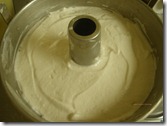
1 cup cake flour
Preheat the oven to 350F. Use a 10” aluminum tube pan with straight sides (the specialty pan for this cake); do not use a nonstick pan.
Put the sugar in the food processor and whiz for 10 seconds or so (alternatively, you can use superfine sugar, but it is expensive). Remove ¼ cup and set the rest aside.
Take out 2 sheets of wax paper. Sift together the flour and ¼ cup sugar onto one sheet of wax paper. Place the sifter onto the other sheet, lift the flour-sugar mixture on its paper and pour it back into the sifter and sift again. Repeat this two more times.
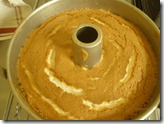
Put the egg whites and water into a standing mixer fitted with the balloon whisk. Beat at medium speed until foamy. Add the vanilla, almond extract if using, salt, and cream of tartar. Turn the mixer on to medium-high and beat, gradually adding the remaining 1 cup sugar, until the egg whites are voluminous and voluptuous, forming soft, rounded mounds and medium-sharp peaks. The meringue should remain very shiny and homogeneous and moist; be
very careful not to overbeat so as not to break the meringue into clumps.
Pour the flour/sugar mixture back into the sifter and sift it over the egg whites, gently folding it in with a rubber spatula, in 5 or 6 batches. Lift and turn the whites carefully, ensuring complete incorporation of the flour. Using the spatula, scoop the batter into the pan, mounding it evenly around the center. Cut through the batter once with a butter knife. Smooth the top.

Bake for about 35 minutes, until golden brown. The top will be cracked, but the cake will not pull from the sides. Remove as soon as it is done—if overbaked, it can collapse--and immediately turn it upside down on a rack or, as my grandmother did, a bottle. Let the cake cool
completely. To remove from the pan, run a long, thin, flexible non-serrated knife (I use my French thin slicing knife, which can be pressed along the shape of the pan) around the outside edge of the pan and the center hole. Grasp the center tube and remove the cake from the pan. Then with one smooth motion, turning the cake as you go, slide the knife between the cake bottom and the pan base.
Lift the cake and place it on a cake plate lined with two pieces of wax paper that meet in the center. Glaze as follows.
Bitter Chocolate Glaze
3 oz unsweetened chocolate
2 T unsalted butter
2 tea corn syrup (optional—Grandma did not use)
½ tea pure vanilla extract
½-3/4 cup water
Pinch salt
Over low heat, melt the chocolate and the butter, stirring occasionally. Add the corn syrup if using, and the vanilla. Gradually add water, stirring, until smooth and pourable, but with enough body to spread—approximately like pastry cream. Pour and spread over the cake with an offset icing spatula or knife (my grandmother did not have an offset spatula), smoothing the sides and making sure to cover the cake in the center hole. Put it into the refrigerator for about 10 minutes to set; remove the wax paper strips.
To serve and store
Cut the cake with a serrated knife into large slices, using a gently sawing motion—no pressing down. They say those
angel food cutters work well, but neither I nor my grandmother have/had one; I like the smooth-faced slices I get from a knife. Serve as is or with
berry coulis or vanilla ice cream. Or both. Other nice accompaniments in place of the chocolate glaze are caramel icing (this makes for a rather sweet dessert) or lemon curd. Store on the counter under a glass dome, or freeze. If there is any left over and it begins to get too dry, try toasting it briefly under a hot broiler; the icing will melt, and form a sauce. But a well-made angel food cake actually keeps quite well for a few days.
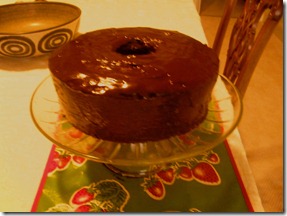

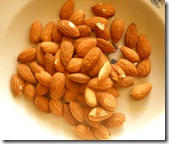 Yes, this is still about leftovers, but I’m tired of reminding myself, and everyone else, that I am still clearing out the freezer. It’s kind of fun, though, to discover things you’d forgotten about. Today it was 8 oz of the Mürbteig pastry from the Cuisinart/New York Cheesecake post, and a bag of almonds from the holdiays, both still in excellent condition (thanks to their fat, of course, and a very cold freezer). I didn’t really have a lot of time, so decided to use the pastry to make a few simple cookies. The dough is so rich and flavorful on its own that it needs little else but a simple garnish, something that almonds are perfect for. You could use these to make little sandwich cookies with buttercream or ganache, but you’d have to have the lightest possible touch, as they break under pressure. Besides, these are very good just as they are.
Yes, this is still about leftovers, but I’m tired of reminding myself, and everyone else, that I am still clearing out the freezer. It’s kind of fun, though, to discover things you’d forgotten about. Today it was 8 oz of the Mürbteig pastry from the Cuisinart/New York Cheesecake post, and a bag of almonds from the holdiays, both still in excellent condition (thanks to their fat, of course, and a very cold freezer). I didn’t really have a lot of time, so decided to use the pastry to make a few simple cookies. The dough is so rich and flavorful on its own that it needs little else but a simple garnish, something that almonds are perfect for. You could use these to make little sandwich cookies with buttercream or ganache, but you’d have to have the lightest possible touch, as they break under pressure. Besides, these are very good just as they are.







